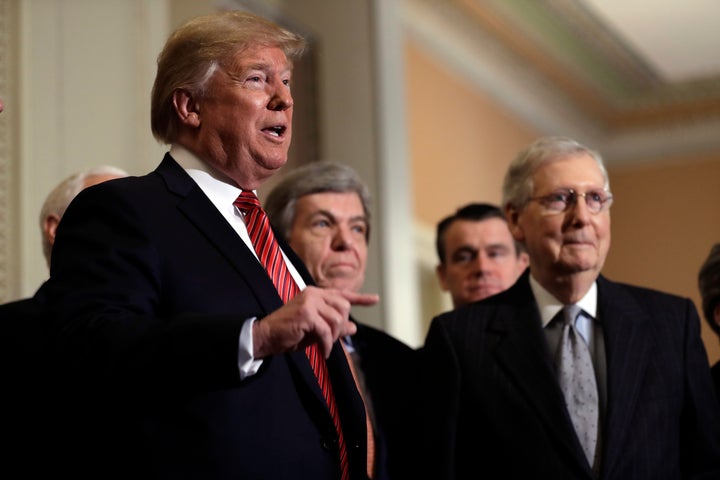Elaine Evans would normally be getting a paycheck deposited in her bank account this week. Instead, the furloughed federal employee will be looking in her mailbox for an unemployment insurance check.
“I should get it this week, hopefully in the next day or so,” said Evans, who lives in Oregon and works for one of the government’s natural resource agencies.
Many federal workers like Evans are about to mark their first expected payday without wages since the partial government shutdown began Dec. 22. As they go longer without pay, more and more are expected to take the step Evans was quick to: file an unemployment claim with their state in order to find a lifeline until the government fully reopens and their pay resumes.
Roughly a quarter of government functions are unfunded as President Donald Trump demands Congress approve more than $5 billion for a wall along the southern border that he used to say Mexico would pay for. Some 380,000 federal workers have been furloughed and are off the job, while another 420,000 are continuing to work as “essential” personnel but without pay.
It would require an act of Congress to retroactively pay both groups of workers once the government reopens, as has typically been done in the past. In the meantime, workers still have mortgage payments to make, credit cards to pay down and groceries to put in their cabinets without knowing when their next paycheck will arrive.
“The longer the shutdown continues, the more claims we will see.”
- William Walton, unemployment insurance director for Virginia
So far, the number of federal workers and contractors seeking unemployment benefits has been rising but appears to remain small as a share of the overall furloughed workforce. Unemployment agencies said they expect the number of claims to rise in the coming days, if more workers fear the impasse will stretch beyond their savings.
The District of Columbia, which has a disproportionate share of federal workers compared with states, had seen 3,745 federal workers and an estimated 822 federal contractors apply for benefits due to the shutdown as of Tuesday night, the D.C. Department of Employment Services told HuffPost. The agency is dealing with the influx of cases by having staff work extended hours.
A total of 1,328 workers in Maryland had applied for unemployment as a result of the shutdown as of Monday night, according to the Maryland Department of Labor, Licensing and Regulation. The state has some of the highest concentrations of federal workers in the country.
“It has been increasing since the start, and like with any extended shutdown, we anticipate that the number of claims will continue to increase,” said Theresa Blaner, an agency spokeswoman.
William Walton, the unemployment insurance director for Virginia, said the state has verified only 279 claims as a direct result of the shutdown.
“We are certainly seeing claims here in Virginia, and we do see them trending upward,” Walton said. “The longer the shutdown continues, the more claims we will see.”

Many federal workers live paycheck to paycheck, and as HuffPost previously reported, they are buckling down for a long shutdown by maxing out credit cards, looking for interest-free loans and borrowing money from relatives, among other budget-tightening moves.
Only workers who are furloughed are eligible for unemployment payments; those who are continuing to work without pay don’t qualify since they are still employed. When federal workers are granted backpay after a shutdown, they are required to pay back any unemployment benefits they received. (The U.S. Office of Personnel Management has issued guidance for federal workers on applying for unemployment.)
Workers are entitled to a weekly payment as a percentage of their annual gross pay, though each state has its own cap on benefits. In general, workers are also required to look for jobs as they receive benefits, even though they know they will return to work for the federal government once the president and Congress reach a deal.
“People aren’t going to get a huge portion of their wages replaced. The average is one-third to half. At least it’s something,” said Michele Evermore, a policy analyst at the National Employment Law Project, a worker advocacy group.
Evans, who is 66, said the unemployment payments she expects are well under her regular salary. The maximum weekly benefit in Oregon is $624. She estimates that would leave her with a shortfall of about $800 over the course of a full month, relative to her normal wages.
“This sitting idle ... we’re going to be further and further behind.”
- Elaine Evans, federal worker
She already paid her rent for the month, but soon she’ll have to deal with a car payment and utilities. She has repayments to make on two loans and reached out to her creditors to ask for leniency.
With 42 years of service with the government, Evans said she would much rather be doing her work than filling out unemployment forms and applying for jobs she won’t be taking.
“This sitting idle knowing that you have work to do and want to serve the public ― we’re going to be further and further behind,” Evans said. “I’m trying not to focus on that. I’m trying to do what I need to do for the unemployment insurance, hunkering down at home and visiting family.”
As for whether the benefits will be enough to cover all her bills, she said she doesn’t know yet.
“We’ll find out if this goes on a couple more weeks,” she said.
HuffPost readers: Are you affected by the government shutdown? Email us about it. If you’re willing to be interviewed, please provide a phone number.

